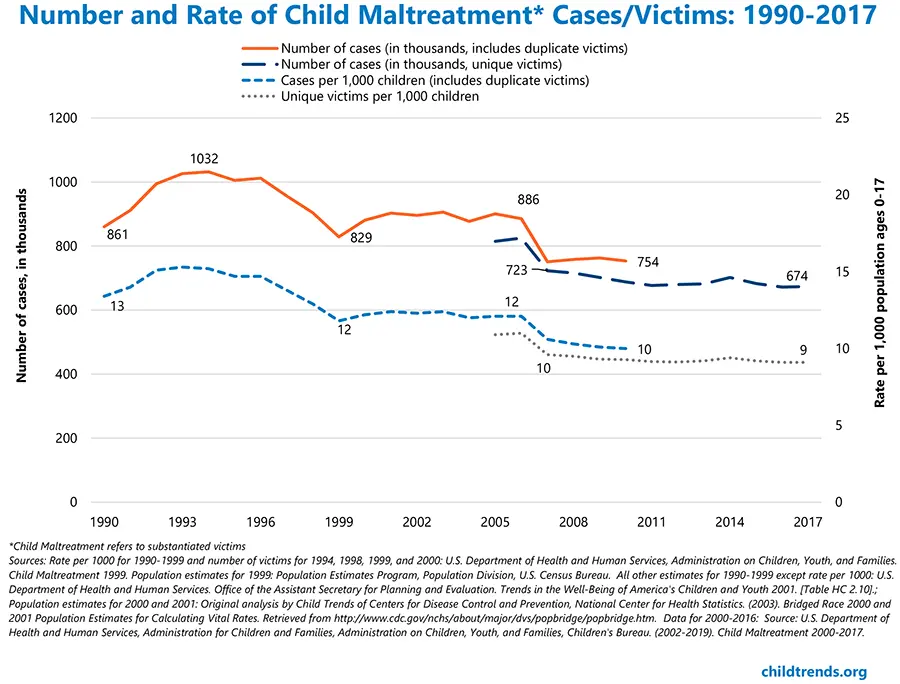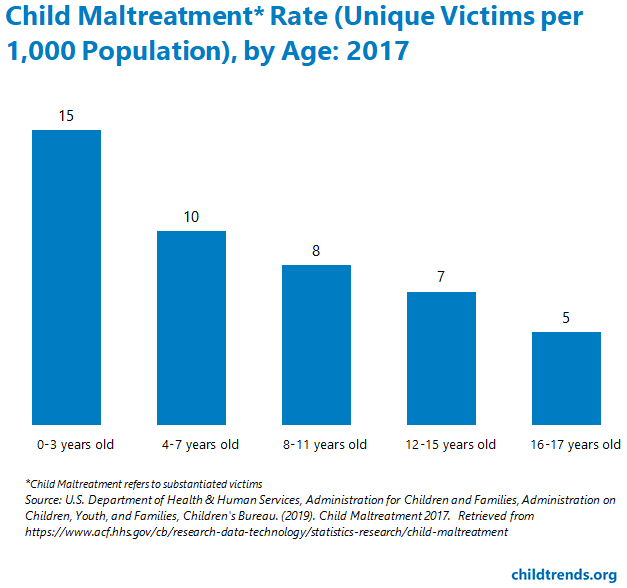Child Maltreatment Databank Indicator
The Child Trends databank of indicators related to child and youth well-being is no longer being updated so that we can focus on data tools and products core to the work of policymakers and other stakeholders, such as:
- State Level Data for Understanding Child Welfare in the United States,
- Black students and students with disabilities remain more likely to receive out-of-school suspensions, despite overall declines,
- Twitter Analysis Can Help Practitioners, Policymakers, and Researchers better understand topics relevant to American Indian/Alaska Native youth, and
- Mapping the Link between Life Expectancy and Educational Opportunity,
Trends in child maltreatment
While legal definitions of child maltreatment vary by state, four types are generally recognized: physical abuse, sexual abuse, neglect (including educational neglect, medical neglect, and other forms), and emotional maltreatment. In the national statistical system that tracks child maltreatment, children are counted as victims if an investigation by a state child welfare agency classifies their case as either “substantiated” or “indicated” child maltreatment. Substantiated cases are those in which an allegation of maltreatment or risk of maltreatment was supported or founded according to state law or policy. Indicated cases are those in which an allegation of maltreatment or risk of maltreatment could not be substantiated, but there was reason to suspect maltreatment or the risk of maltreatment.[1]
From 1990 to 1994, the number of cases of child abuse or neglect that were either substantiated or indicated[2] rose from 861,000 to 1,032,000, reaching a rate of 15 per 1,000 children under age 18 in 1994. From 1994 to 1999, the trend reversed, with the number of cases dropping to 829,000, a rate of 12 per thousand, in 1999. The number of cases increased slightly from 1999 to 2001; then it leveled off until 2006, with the rate staying fairly constant throughout that period. After a sharp drop in both rate and number of maltreated children (excluding duplicate cases) from 2006 to 2007, the number and rate of maltreated children continued to decline until 2012, when both began to rise again. In 2017, there were approximately 674,000 maltreated children substantiated in the United States, a rate of 9 per thousand. Note that these data reflect states’ definitions of what constitutes maltreatment; these definitions vary across states and may change over time (Appendix 1).

Differences by age
Young children experience higher rates of maltreatment than older children. In 2017, children 3 and younger had a maltreatment rate of 15 per 1000, compared with 10 per 1000 for children ages 4 to 7, 8 per 1000 for ages 8 to 11, 7 per 1000 for ages 12 to 15, and 5 per 1000 for children ages 16 to 17 (Appendix 2).

Differences by race and Hispanic origin*
Reflecting numerous factors, including poverty and institutional biases, non-Hispanic black, American Indian or Alaska Native, and multiple-race children have higher rates of reported child maltreatment than other children. In 2017, the reported maltreatment rate for non-Hispanic black children was 14 per 1,000 children, 14 per 1,000 for American Indian and Alaska Native children, and 11 per 1,000 for multiple-race children. This compares with rates of 9 for non-Hispanic Pacific Islander children, 8 for Hispanic children, 8 for non-Hispanic white children, and 2 for non-Hispanic Asian children (Appendix 2).
* Estimates for white, black, American Indian/Alaskan Native and Asian/Pacific Islander youth in this report do not include Hispanic youth. Hispanic children and youth may be of any race.

Differences by type of maltreatment
Rates of reported neglect are higher than those for other types of child maltreatment. In 2017, 7 children per 1,000 were reported victims of neglect, compared with 2 for physical abuse, 1 for sexual abuse, and 1 for psychological or emotional abuse (Appendix 2).
Among all reported maltreated children, the proportion with reported neglect increased from 49 percent in 1990 to 75 percent in 2017, while those with reported sexual abuse declined from 17 to 9 percent, and the share with reported physical abuse declined from 27 to 18 percent. Less frequent types of maltreatment, including those classed as “unknown,” accounted for the balance (Appendix 1).
Rates of physical and sexual abuse have declined over the past two decades, while rates of neglect have fluctuated and remained the highest among the types of maltreatment. From 1990 to 2017, rates of substantiated physical abuse declined by 40 percent and sexual abuse rates by 62 percent; by contrast, rates of substantiated neglect fell by 8 percent over this period.[3]
Other estimates
State and local estimates
State estimates for 2017 are available at U.S. Department of Health and Human Services, Administration for Children and Families, Administration on Children, Youth, and Families, Youth and Families, Children’s Bureau. (2019). Child maltreatment 2017 [Tables 3.1-3.8]. Washington, DC: Author. Retrieved from https://www.acf.hhs.gov/sites/default/files/cb/cm2016.pdf.
The KIDS COUNT Data Center also has state-level data, including the percent of victims who received post-investigation services, available at: KIDS COUNT Data Center. (2019). National kids count [Data tool]. Baltimore, MD: Annie E Casey Foundation. Retrieved from https://datacenter.kidscount.org/data#USA/2/35/36,37,38,41,40/char/0.
International estimates
Estimates of child maltreatment in European countries are available from the World Health Organization: World Health Organization. (2013). Scale and consequences of the problem. In D. Sethi, M. Bellis, K. Hughes, R. Gilbert, F. Mitis, & G. Galea (Eds.), European report on preventing child maltreatment. Geneva, Switzerland: Author. Retrieved from http://www.euro.who.int/en/health-topics/disease-prevention/violence-and-injuries/publications/2013/european-report-on-preventing-child-maltreatment.
Data and appendices
Data sources
- Data for 2000-2017: U.S. Department of Health and Human Services, Administration for Children and Families, Children’s Bureau. (2002-2019). Child maltreatment 2000-2017. Washington, DC: Author. Retrieved from https://www.acf.hhs.gov/cb/research-data-technology/statistics-research/child-maltreatment.
- Additional data for 2000-2001:S. Department of Health and Human Services, Centers for Disease Control and Prevention, National Center for Health Statistics. (2003). 2000 and 2001 Population Estimates for Calculating Vital Rates. Washington, DC: Author. Retrieved from http://www.cdc.gov/nchs/about/major/dvs/popbridge/popbridge.htm.
- Data for 1990-1999 (except rate per thousand): U.S. Department of Health and Human Services, Office of the Assistant Secretary for Planning and Evaluation. (2001). Trends in the well-being of America’s children and youth 2001 [Table HC 2.10]. Washington, DC: Author. Retrieved from https://aspe.hhs.gov/report/trends-well-being-americas-children-and-youth-2001.
- Data on rate per thousand for 1990-1999: U.S. Department of Health and Human Services, Administration for Children and Families, Children’s Bureau. (2000). Child maltreatment 1999. Washington, DC: Author. Retrieved from http://www.acf.hhs.gov/programs/cb/pubs/cm99/index.htm.
Raw data source
U.S. Department of Health and Human Services, Children’s Bureau, National Child Abuse and Neglect Data System (NCANDS).
http://www.acf.hhs.gov/programs/cb/resource/about-ncands
Appendices
Background
Definition
Child maltreatment can be defined as “behavior towards [a child] . . . which (a) is outside the norms of conduct, and (b) entails a substantial risk of causing physical or emotional harm. Behaviors included will consist of actions and omissions, ones that are intentional and ones that are unintentional.”[4] Four types of maltreatment are generally recognized, including physical abuse, sexual abuse, neglect (including educational neglect, medical neglect, and other forms), and emotional maltreatment. Before 2009, all data in this report represent all substantiated or indicated cases from reporting states in a given year. For 2009 and subsequent years, duplicate victims (that is, those reported to have experienced more than one incidence of maltreatment) are excluded, and data represent the number of children who had at least one substantiated or indicated case in that year. Not all states report duplicate victims, so the total number of unique victims is an estimate based on available numbers. Legal definitions of maltreatment vary by state.
Citation
Child Trends. (2019). Child maltreatment. Retrieved from https://www.childtrends.org/indicators/child-maltreatment.
Endnotes
[1] States use different terminology to refer to the status of maltreatment reports that have, upon investigation, yielded evidence that abuse or neglect has occurred.
[2] U.S. Department of Health and Human Services, Administration for Children and Families, Children’s Bureau. (2012). Child maltreatment 2011. Washington, DC: Author. Retrieved from http://www.acf.hhs.gov/programs/cb/resource/child-maltreatment-2011.
[3] Finkelhor, D., Saito, K., & Jones, L. M. (2016). Updated trends in child treatment. Durham, NH: University of New Hampshire, Crimes Against Children Research Center. Retrieved from http://www.unh.edu/ccrc/pdf/Updated%20trends%202014.pdf.
[4] Christoffel, K. K., Scheidt, P. C., Agran, P. F., Kraus, J. F., McLoughlin, E., & Paulson, J. A. (1992). Standard definitions for childhood injury research: Excerpts of a conference report. Pediatrics, 89(6), 1027-1034.
© Copyright 2024 ChildTrendsPrivacy Statement
Newsletter SignupLinkedInThreadsYouTube